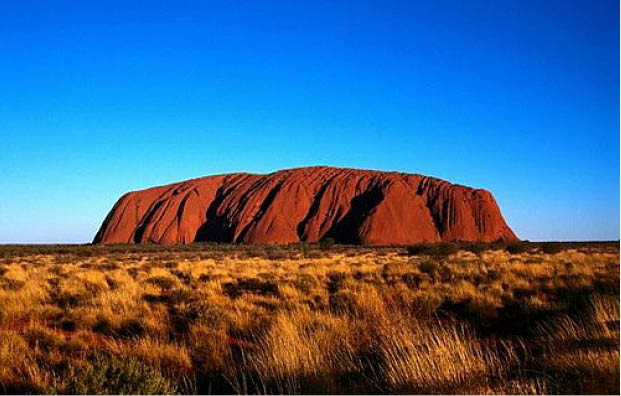The spiritual heart of Australia is undergoing a transformation for travellers and local communities, writes Helen Anderson.
Little has changed at Uluru in 30,000 years, geologically speaking. Apart from water erosion deepening the fissures that score the flanks of Uluru and Kata Tjuta, the monumental splendour of the rust-red rocks and their intense colours at sunrise and sunset appear timeless.
Just beyond the national park, however, at Voyages Ayers Rock Resort and Longitude 131, the five-star tented camp, the pace of change in the past four years has been furious. “The destination has undergone a complete rejuvenation,” says Karena Noble, the resort’s public relations director. “Every aspect of the guest experience has been examined and improved with the aim of creating a centre of excellence in indigenous tourism in the spiritual heart of Australia.”
Not since the landmark agreement of 1985 – in which the Australian Government handed Uluru back to its traditional owners, the Anangu, who in turn leased and now jointly administer it with the National Parks and Wildlife Service – has there been such substantial change.
There were two indigenous employees at the Red Centre resort when it was bought in October 2010 by the Indigenous Land Council, with a mission to turn the former Voyages Hotels & Resorts complex into a showcase of indigenous employment and tourism. Managed by a subsidiary, Voyages Indigenous Tourism Australia, the resort’s five accommodation sites, airport and tour operations at Yulara, near Uluru, now has a national indigenous training academy, 252 indigenous employees and plans to boost that number to half its workforce of about 750 by 2018.
Travellers had long complained there were few ways to learn about the culture of the region’s traditional owners. In response, says Noble, a suite of free daily experiences designed to help guests engage with indigenous culture – from traditional dance and interactive didgeridoo performances to guided botanical walks and storytelling sessions – has proved popular.
The new owners spent $30 million refurbishing Sails in the Desert, the resort’s top-end hotel, and are progressively upgrading the other four accommodation options. The range of guest activities has been boosted to about 65 pursuits, including skydiving, cycling around the rock and a premium dining-under-the-stars experience for no more than 20 people at a time.
The changes at Longitude 131 have been even more swift. Baillie Lodges, owned by James and Hayley Baillie, took on a 30-year operating lease in November 2013 and immediately embarked on the $2 million first stage of a three-year plan. Managing director James describes it as “immediate renewal”. The most obvious changes are the appearance of works by local indigenous artists, commissioned by Hayley in tandem with art centres in the Anangu Pitjantjatjara Yankunytjatjara lands. “A core part of our vision is the celebration of indigenous heritage and culture,” says James, who sees this as complementing the existing focus in guest tents and lounge areas on the achievements of white explorers; each of the tents is named after a white pioneer and features their journals and photographs. Like the art, all the enhancements are commissioned for the lodge, from ceramics by Malcolm Greenwood and uniforms by RM Williams to the group’s customised “Baillie beds” and bespoke furniture by Melbourne designers Pierre and Charlotte Julian, and Arthur G. The look is lighter: less heritage, more contemporary.
The same could be said for the menus under chef Seona Moss, which are both light and satisfying after a day of touring. Moss’s light touch is best seen in dishes such as bark-wrapped Murray River cod, choko and pickled cabbage, and in the house salad, which, with its lively mix including fennel, heirloom tomatoes and avocado, is a fine example of the oft-neglected standard. Moss, who trained at E’cco in Brisbane and has done stints at Vue de Monde and Noma, has access to premium Australian produce – raw goat-milk emme cheese from Hindmarsh Valley Dairy, Daintree chocolate, the aforementioned sustainably harvested Murray River cod – and seasonal bush food, including quandongs and muntries during my visit.
More extensive work on Longitude will start this year. With architect Max Pritchard, the Baillies are planning two new two-bedroom tented pavilions, each with a pool; a spa; a new entrance to the Dune House, the communal space; and rock-facing balconies added to the existing tents to house daybeds, outdoor fireplaces and luxury swags for a night under the stars. The dunetop behind Longitude, with its priceless view, will feature a heated infinity pool, decks and terraces with outdoor dining nooks.
With a private helipad and new fleet of vehicles, the range of guest activities at Longitude has been broadened and “rechoreographed” to be more flexibile: sunset cocktails at secluded spots around Uluru; private guided walks in neighbouring Kata Tjuta; and helicopter expeditions to Cave Hill and Mount Conner, a lesser-known but spectacular monolith 100 kilometres east of Uluru.
Some of the most memorable experiences are the simplest. James loves running at sunrise around the base of the rock. “It’s a 10-kilometre circuit – all flat, quiet, a little eerie and very, very special.”
Before I fall asleep one night I flick a bedside switch to raise the shades on the wall of windows in my tent.
I wake as the horizon appears and lie propped up for an unforgettable hour, as the sun rises over Uluru.
http://www.gourmettraveller.com.au/travel/travel-news-features/2015/1/uluru-rising/




